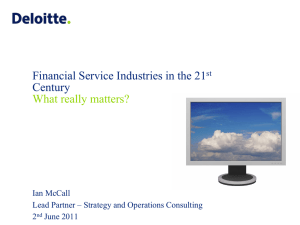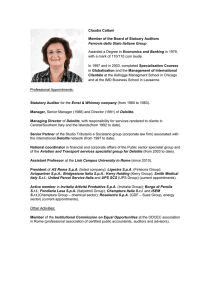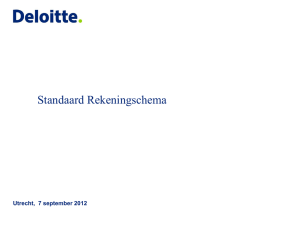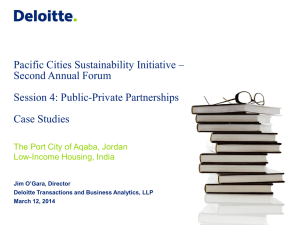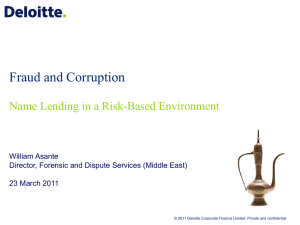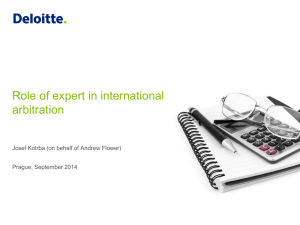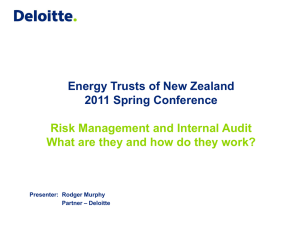Stephen Reid Delloite CSG Powerpoint Presentation
advertisement
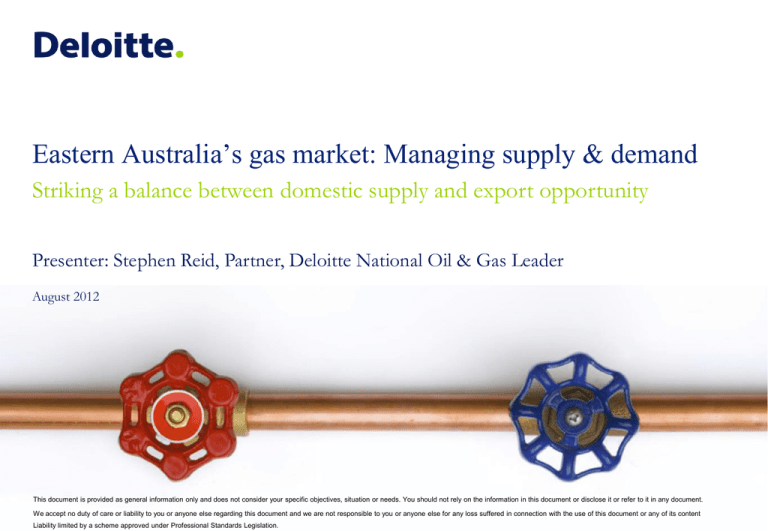
Eastern Australia’s gas market: Managing supply & demand Striking a balance between domestic supply and export opportunity Presenter: Stephen Reid, Partner, Deloitte National Oil & Gas Leader August 2012 This document is provided as general information only and does not consider your specific objectives, situation or needs. You should not rely on the information in this document or disclose it or refer to it in any document. We accept no duty of care or liability to you or anyone else regarding this document and we are not responsible to you or anyone else for any loss suffered in connection with the use of this document or any of its content Liability limited by a scheme approved under Professional Standards Legislation. Eastern Australia’s gas market issues How to balance the potential to transform Eastern Australia into one of the world’s largest LNG exporters with security of domestic gas supply? Pressure on gas supply in Eastern Australia over coming decades Significant amounts of gas will need to be commercialised over the next 20 years Will Australia’s proven reserves be able to be commercialised in time? A thriving and competitive domestic gas industry is critical to ensuring the competitively priced energy that is a key economic driver of growth 1 Electricity price pressures New South Wales has seen energy costs rise significantly in recent years Electricity prices in Sydney increased by 61% between 2005 and 2010. From 2014, the NSW electricity prices are projected to grow at 2% per year (in real terms). From 1 July 2012, the NSW electricity prices have increased by 18%; half of the overall increase is because of rising transmission costs for poles and wires, while the other half is due to the introduction of the carbon tax. 2 Industry and government need to address difficult questions 1. Meeting production demand as new LNG projects come online Sufficient reserves? Timely production ramp-up? Given supply constraints, gas may be directed out of the domestic market $50 billion Investment sanctioned Six LNG trains around the port of Gladstone 25mtpa of LNG Collective production from facilities At what price, and at what pace, can the industry bring on supply to meet both domestic and committed LNG needs? 3 Meeting the demand It’s critical we secure an affordable domestic gas market It’s estimated that by 2030, domestic gas demand across Eastern Australia will be in the range of 1200PJ/year (41% increase) to 1,850PJ (62% increase). In addition, almost 40% of advanced electricity generation projects are in the gas sector and gas-powered generation is expected to grow on average 5% per year, effectively tripling installed capacity by 2020. Declining conventional gas reserves coupled with forecast growth in domestic gas demand, will increase reliance on nonconventional gas reserves such as coal seam gas to supply both the growth demand from LNG contracts and domestic gas needs. 4 Industry and government need to address difficult questions 2. Increased regulation of the coal seam gas industry Government scrutiny and regulation of the industry Regulatory process is likely to result in additional costs and time delays 5 Industry and government need to address difficult questions 3. Ensuring a reliable domestic supply stream Some estimates suggest that over 100,000 Estimated Eastern Market gas production costs PJ of gas on the East Coast can be extracted at less than $4/GJ – is this likely? BREE suggests that “consumers in the Eastern Gas Market will need to adjust to higher prices” in the medium term Domestic supply pressures are likely to Source: BREE intensify With LNG project owners now committed to supplying LNG customers first, how can we secure adequate domestic gas supplies at reasonable prices to meet industrial and commercial customer needs? Which trade-exposed industries will be affected most by higher gas prices and how can they respond? 6 Industry and government need to address difficult questions 4. Delivering on a carbon future in the face of rising gas prices East Coast gas prices are expected to potentially double over the next few years Gas-powered generation investment is highly sensitive to prevailing gas prices The carbon price would need to rise to over $50 a tonne for gas-fired generation to remain competitive Will the high gas price create policy challenges for the Government in meeting its carbon reduction targets if coal fired power remains the more economical option? 7 Industry and government need to address difficult questions 5. Timing mismatch of yet-to-be-proved shale gas Australia is one of the most prospective World Shale Gas Resources countries for shale gas development Five to ten years to develop and commercialise those reserves Source: Energy Information Administration Undoubtedly the industry has real potential to deliver supply, but will it be able to do it quickly enough? 8 What does all this mean for the New England region? Significant opportunity to develop local industry, create jobs and secure supply Energy security is paramount for local East Coast domestic contracts expiry business and retail consumers Santos, AGL, Dart Energy and others have interests in the tenements in this region that could be developed Local industry and community can benefit Source: BREE Local indigenous industry can develop – creation of thousands of jobs Now is the time to act 9 Deloitte contacts & Thought Leadership Stephen Reid Partner | Corporate Finance Valuations National Resources Valuations Leader Direct: +613 9671 7506 Email: stereid@deloitte.com.au 10 General information only This presentation contains general information only, and none of Deloitte Touche Tohmatsu Limited, its member firms, or their related entities (collectively the “Deloitte Network”) is, by means of this presentation , rendering professional advice or services. Before making any decision or taking any action that may affect your finances or your business, you should consult a qualified professional adviser. No entity in the Deloitte Network shall be responsible for any loss whatsoever sustained by any person who relies on this presentation. About Deloitte Deloitte refers to one or more of Deloitte Touche Tohmatsu Limited, a UK private company limited by guarantee, and its network of member firms, each of which is a legally separate and independent entity. Please see www.deloitte.com/au/about for a detailed description of the legal structure of Deloitte Touche Tohmatsu Limited and its member firms. Deloitte provides audit, tax, consulting, and financial advisory services to public and private clients spanning multiple industries. With a globally connected network of member firms in more than 150 countries, Deloitte brings world-class capabilities and deep local expertise to help clients succeed wherever they operate. Deloitte's approximately 170,000 professionals are committed to becoming the standard of excellence. About Deloitte Australia In Australia, the member firm is the Australian partnership of Deloitte Touche Tohmatsu. As one of Australia’s leading professional services firms. Deloitte Touche Tohmatsu and its affiliates provide audit, tax, consulting, and financial advisory services through approximately 5,400 people across the country. Focused on the creation of value and growth, and known as an employer of choice for innovative human resources programs, we are dedicated to helping our clients and our people excel. For more information, please visit our web site at www.deloitte.com.au. Liability limited by a scheme approved under Professional Standards Legislation. Member of Deloitte Touche Tohmatsu Limited © 2012 Deloitte Touche Tohmatsu

